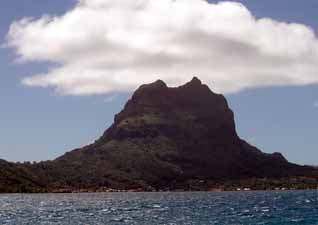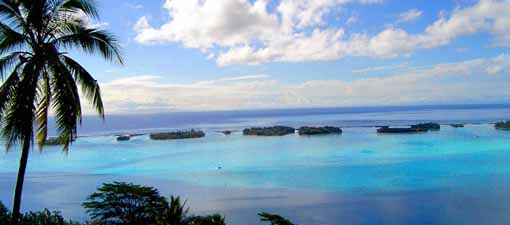Bora Bora

Avalon
Mon 13 Oct 2003 04:05
 Made famous by Michener's "Tales of the South Pacific",
Bora Bora "the most beautiful island in the world" hasn't really changed since
it's days of being an
American air base. Well, there is the small fact that
there are now 14 over the top, over the water, luxury resorts and that the
bi-weekly cruise ships deposit
1000 portly white tourists
to shore at a time. Regardless of this as the sun rises over Bora Bora's
distinctive peak and tints it's shallow lagoon waters every
shade of blue her timeless
beauty remains.
   The locals, although often face to face with the worlds
rich and famous, still live modestly paddling canoes and following a
typical island life.
Outside the resorts of the southern tip, the circular
road around the rest of the island is rough and potholed with numerous kids,
dogs and pigs moving
out of the way as the occasional car passes
by. Even now all housing is at sea level and the steep slopes remain
heavily vegetated coving the many
relics of the U.S. war presents.
 We celebrated the AFL footy grand final with some new
found Australian friends, the Beechamp Family from Brissy. A cold local beer
comes in a can
as delightful as the surroundings. The most striking
aspect of French Polynesia's culture was ever present hibiscus flower motifs.
Shirts, shorts, car seat
covers and even whole building interiors were decorated
with this classic tropical print.    We did not need to pay a thousand dollars a night for a
bungalow over the water to enjoy the traditional feast and dance performance at
the famous Sofitel
Marara (flying fish hotel).
Built for the making of the 1968 Dino de Laurentiis movie "Hurricane" we
finished our Bora Bora experience in high style.
After eating copious amounts of suckling pig, cooked in
the traditional earth oven, we were treated to many hipshaking
stunning Polynesian dancers. Sitting in
Mia Farrow's seat at the bar
was a great escape from the feeling of being a grotty yachty!   Once again we are about to sail west into the setting
sun, this time towards the Kingdom of Tonga, 1300 miles away. It is one of
the only places
in the Pacific never to have
been occupied by a colonial power.
 |